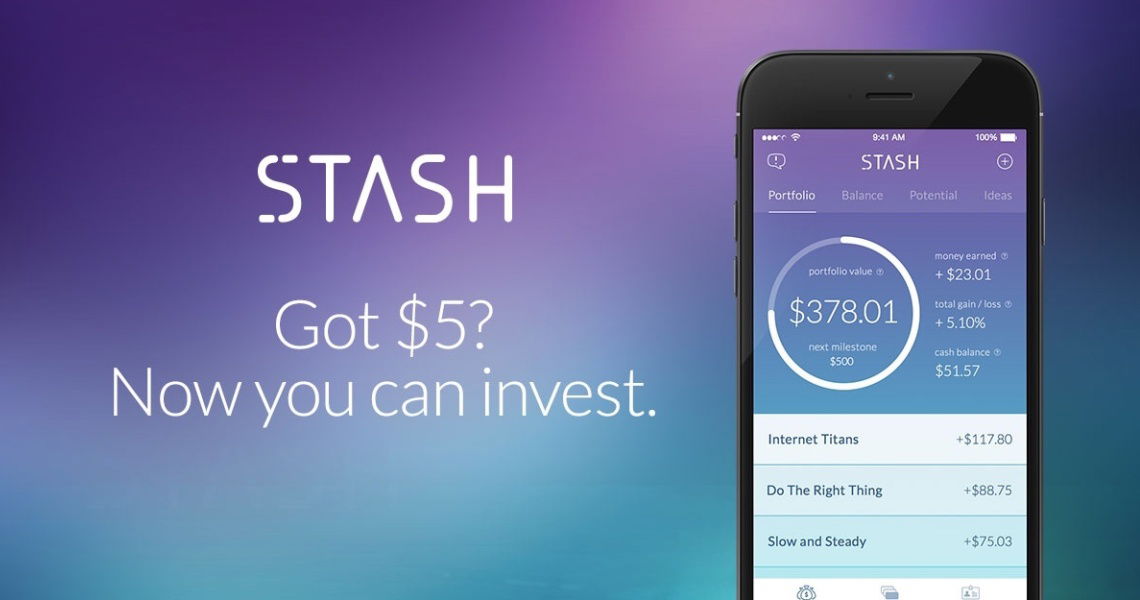Contrary to popular belief, starting an investment portfolio doesn’t require a large sum of money. In fact, with just $500 or less, you can easily kickstart your investment journey in the stock market.

12 Best Ways to Invest $500
If you’re looking for other ways to invest, but don’t have much cash, here are twelve of the best ways to invest $500 or less.
1. Micro-Investing
With micro-investing, even those with limited disposable income can join the game, starting with as little as $5. Ideal for college students or novice investors, there are a multitude of micro-investing apps available, many requiring an initial investment of $500 or less.
These user-friendly platforms offer a simple way to dip your toes into the investment world. Check out these five top micro-investing apps to start your journey today.
Robinhood
If you’re a beginner investor, Robinhood is an excellent choice. Unlike many other platforms, Robinhood has no minimum balance requirement and doesn’t charge any fees for trading.
It is also very easy to use the app. Additionally, Robinhood stands out among micro-investing platforms, offering the ability to trade in a wide range of assets, including full stocks, mutual funds, options, and cryptocurrencies.
To find out more, read our comprehensive review of Robinhood.
Stash
Stash accommodates the needs of a diverse range of investors. Upon signing up, you’ll take a quick survey to assess your risk tolerance, allowing you to determine the amount and frequency of your investments.
With Stash, you also have the power to select the industries and companies you want to invest in. For example, if you’re passionate about sustainability, you can easily choose to invest only in eco-friendly organizations.
Webull
Webull is built for users who want more than just passive investing. It offers commission-free trading on stocks, ETFs, and options, with advanced charting tools and extended-hours trading.
There’s no minimum deposit to open an account, and it appeals to beginners who want to grow into more active strategies over time.
Betterment
For those who want to be hands-on with their micro-investing, Betterment may be the answer. The platform takes care of the investing for you, while also giving you the option to work with a financial advisor and have a say in your investment portfolio.
Signing up is easy, with no minimum balance required for its basic plan. However, it’s important to note that Betterment charges a 0.25% monthly fee on your investments.
2. Exchange-Traded Funds (ETFs), Mutual Funds, or Index Funds
For those looking to invest $500, exchange-traded funds (ETFs), mutual funds, and index funds are all great options. ETFs offer a basket of securities that can be exchanged on the market, just like a stock. You can find plenty of online brokers that offer a wide selection of commission-free ETFs.
Mutual funds are managed by a professional broker and aim to beat a given stock market index, while index funds are designed to match the index and grow from there.
All three types of investments have low expense ratios, low fees and commissions, and offer broad, diversified exposure to the stock market.
See also: ETFs vs. Mutual Funds: What’s the Difference?
3. Buy Bitcoin
For some, investing in cryptocurrency may be too risky and volatile for their taste. However, Bitcoin has had an average growth of over 100% per year for the past 12 years! In fact, if you had invested $500 in Bitcoin five years ago, you’d have approximately $90,000 today.
If you’re interested in getting into crypto, Coinbase is a great place to start. They’ll give you $10 in free Bitcoin when you buy or sell $100 or more in crypto. Coinbase also offers ways for you to earn up to $32 worth of crypto for free.
See also: 5 Best Ways to Buy Bitcoin With a Bank Account
4. Open a Roth IRA
It’s never too late to start planning for retirement, and a Roth IRA might be the way to go. With this retirement savings plan, you contribute after-tax money to an investment account, which you can then withdraw tax-free when you reach retirement age.
However, there are a few things to keep in mind before opening a Roth IRA. An individual retirement account (IRA) is meant for long-term savings and withdrawing the money before you turn 59 and a half may result in penalties. If you anticipate needing to access the funds sooner, consider exploring alternative options.
5. Start an Online Business
If you’re looking for an unconventional way to invest your money, why not try starting an online business? Traditional brick-and-mortar businesses require a lot of capital to get up and running, but the same cannot be said for an online business.
You won’t need office space, a warehouse, or expensive equipment. In all likelihood, you won’t need to invest $500. It will cost much less than that. Here are some popular online business ideas:
- Starting and monetizing a blog
- Selling things on eBay or Craig’s List
- Selling services like freelancing writing, editing, or graphic design
- Opening an e-commerce store
- Buying items and flipping them for profit
6. Use Robo-Advisors
Investing your money with a robo-advisor might be a smart choice. A robo-advisor is a user-friendly online investment platform that creates a tailored and diversified portfolio for you based on your answers to a questionnaire.
Although robo-advisors have limited services compared to working with a financial advisor and do not offer personalized advice, they have low fees and make investing with as little as $500 in the stock market accessible. Additionally, robo-advisors offer multiple investment options, including:
- Roth IRAs
- Traditional IRAs
- Solo 401(k)s
- Taxable accounts
7. Open a High-Interest Savings Account
If you’re still exploring your options and not ready to invest yet, consider opening a high-yield savings account. The best high-interest savings accounts currently pay about 3% to 5% in interest.
While the returns may not match the potential gains of the stock market, having a savings account serves as a solid backup plan and provides peace of mind for the future. Don’t let your funds go to waste – take advantage of this secure and profitable opportunity.
8. Open a High-Yield CD
A high-yield certificate of deposit (CD) is a low-risk investment option that offers a higher rate of return compared to traditional savings accounts. CDs work by allowing you to deposit a fixed amount of money for a set period of time, typically ranging from a few months to several years. In exchange for this commitment, the financial institution offering the CD agrees to pay you a higher rate of interest compared to traditional savings accounts.
Opening a high-yield CD with $500 or less is a straightforward process that can be done through a bank or credit union. You simply choose the term length and deposit amount that works best for you, and the institution takes care of the rest. As your money grows over time, you’ll earn a higher return on your investment compared to traditional savings accounts.
Just remember that CDs typically have early withdrawal penalties. So, make sure you’re comfortable with the term length and the amount you’re depositing before opening an account.
9. Invest in Real Estate Crowdfunding
Investing in real estate is not limited to traditional methods, even with just $500. A prime example is real estate crowdfunding via platforms like Fundrise.
Fundrise provides investment opportunities in both commercial and residential properties with a minimum investment of just $10. This eliminates the requirement for a large capital investment, making real estate investment accessible to a wider range of individuals.
Check out our in-depth Fundrise review.
10. Pay Down Your Debt
Reducing debt is a sound investment for securing your future, particularly concerning high-interest credit card debt. The Federal Reserve reveals that the average credit card interest rate can be as much as 15% or higher, with a low credit score only driving the APR to even more astronomical heights.
Think about it, if your APR is at its highest, you may be shelling out hundreds of dollars each month just in interest charges. But by focusing your efforts on paying down your debt, you stand to save yourself not just money, but countless headaches in the coming year. With the possibility of freeing up thousands of dollars, it’s an investment worth making.
11. Try Peer-to-Peer (P2P) Lending
Peer-to-peer lending offers a unique twist on conventional lending methods. Rather than seeking loans from traditional banks, borrowers turn to platforms such as Prosper, connecting with investors like yourself.
By participating in P2P lending, you have the opportunity to generate a steady monthly income by lending funds to individuals or businesses. The added bonus? The money you earn is deposited directly into your account, providing a convenient and hands-off approach to investing.
12. Invest in Your Financial Education
Investing in your financial literacy may be the most valuable investment you’ll ever make. For a nominal fee of just $5 to $15, you can access top-notch personal finance books or audiobooks that can transform your financial future.
Take “Rich Dad Poor Dad” for example, available on Amazon for as low as $6.82 for the Kindle edition or $11.36 for the paperback. And if audiobooks are more your style, a month of Audible membership costs only $14.95.
You can expand your knowledge on real estate investing, stock investment strategies, and fundamental money management skills to help you get out of debt and attain financial independence.
And if reading isn’t your preferred method of learning, there are plenty of affordable online courses available. With so many options, it’s remarkable how much financial education you can gain for less than $500.
Frequently Asked Questions
What is the best way to invest $500?
The best way to invest $500 depends entirely on your personal financial status and objectives. If you’re just starting out investing, consider investing in a low-cost and diversified mutual fund or ETF. These investment vehicles offer the advantage of spreading your funds across a range of stocks and bonds, mitigating the risk associated with any single investment.
Other options to ponder include setting up a Roth IRA or investing in a high-yield savings account. The choice that works best for you ultimately hinges on your risk appetite, investment timeline, and financial aspirations.
Is it possible to invest $500 in stocks?
Absolutely! With just $500, you can venture into the world of stock investing. Micro-investing apps provide the opportunity for you to invest in individual stocks or opt for an ETF that follows a particular index.
It’s crucial to conduct thorough research and seek the guidance of a financial advisor to determine the best investment strategy that aligns with your unique circumstances.
Is it worth investing $500 in a robo-advisor?
Investing your $500 via a robo-advisor can be a wise decision. These digital platforms leverage algorithms to manage your investments, offering a more passive investment strategy.
Furthermore, robo-advisors tend to be more economical than human financial advisors, making them a fantastic choice for individuals seeking to initiate their investment journey.
What are the risks of investing $500?
Starting your investment journey with just $500 can be a smart move. However, it’s important to keep in mind the inherent dangers that come with investing.
Remember, no investment is entirely risk-free and there’s always a chance of losing your funds. To ensure you make an informed decision, conduct thorough research and consult a financial expert who can guide you towards the best option suited for you.
Bottom Line
We hope that this article has demonstrated to you that investing can be simple and accessible, even with a limited budget. You can start investing immediately with a modest amount of funds. If you’re not quite ready to invest, consider paying off high-interest credit card debt, increasing your income, and establishing an emergency fund.




